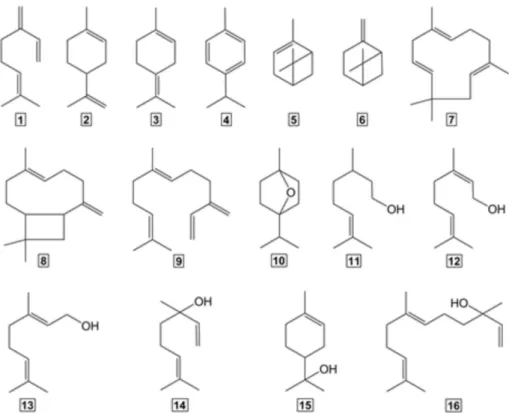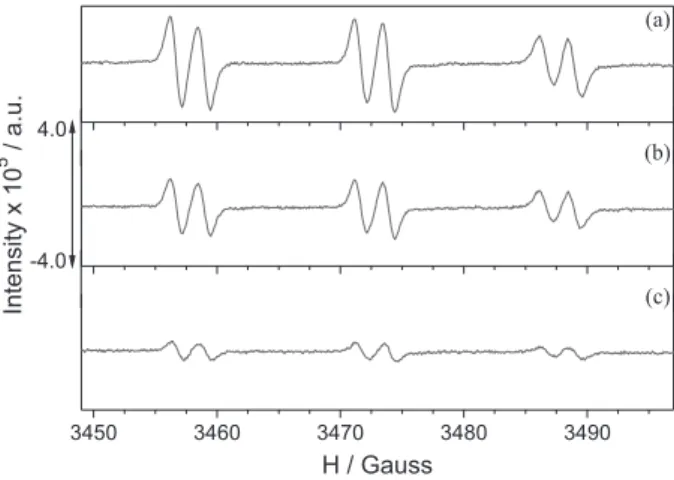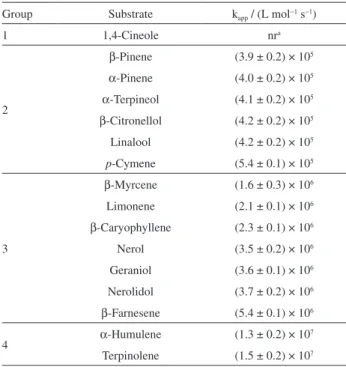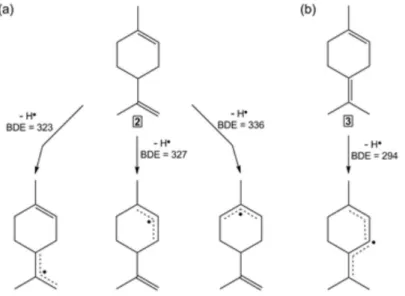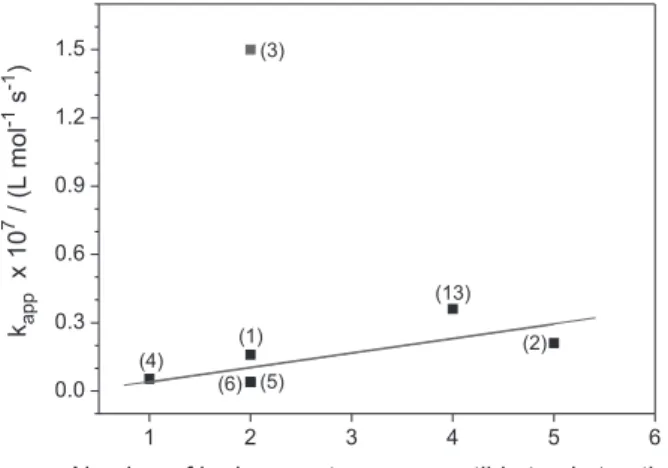Article
Printed in Brazil - ©2015 Sociedade Brasileira de Química0103 - 5053 $6.00+0.00
A
*e-mail: drcardoso@iqsc.usp.br
Mechanism of Hop-Derived Terpenes Oxidation in Beer
Natália E. C. de Almeida, Inara de Aguiar and Daniel R. Cardoso*
Instituto de Química de São Carlos, Universidade de São Paulo, Av. Trabalhador São-Carlense 400, CP 780, 13560-970 São Carlos-SP, Brazil
Terpenes are the main constituents of hops essentiol oil and contribute to the singular sensory properties of beer. However, terpenes are sensitive to oxidation leading to quality loss during beer aging. Herein, the reactivity of terpenes towards 1-hydroxyethyl radical has been determined employing a competitive kinetic approach using the spin-trap α
-(4-pyridyl-1-oxide)-N-tert-butylnitrone (4-POBN). The apparent rate constant (kapp) for the reaction of terpenes with
1-hydroxyethyl radical ranges from (3.9 ± 0.2) × 105 to (1.5 ± 0.2) × 107 L mol−1 s−1 for β-pinene
and terpinolene, respectively. The reaction involves hydrogen atom transfer from the terpene to 1-hydroxyethyl radical rather than electron-transfer and the rate constant is shown to be dependent on the number of allylic and benzylic hydrogen atoms and on the value of the bond dissociation enthalpy for the weakest C−H bond. The results provide a better understanding on the mechanism behind terpene decomposition in beer brewing and aging process and may further contibute to improve the oxidative stability of the herb-flavored beverages.
Keywords: beer, 1-hydroxyethyl radical, terpenes, kinetics, oxidation
Introduction
Hops (Humulus lupulus L.) are essential for the brewing process in order to confer the singular sensory properties of beer.1,2 Terpenes are the principal constituents of hops
essential oil, which make up to 3% (v/m) of the hop cone.3
It is well-known that the composition of hops essential oil depends on the hop genotype, being identified over 200 compounds in its essential oil, some of them have been used for distinguishing among different hop varieties.3-5 The
major terpenes present in hop and beer basically comprise monoterpenes (C10) and sesquiterpenes (C15), which exhibit
strong sensory qualities.5 The chemical structure of the
major brewing terpenes is illustrated in Figure 1, which includes typical terpene hydrocarbons (1-9), terpene epoxide (10) and terpene alcohols (11-16).
Although terpene hydrocarbons like β-myrcene (1), α-humulene (7), β-caryophyllene (8), and β-farnesene (9) have been shown to be the main components of hop oil,3,6 the
predominant terpenes in finished beer are terpene alcohols due their hydrophilic properties,6 especially linalool (14)
and geraniol (13), which have been found in appreciable concentrations (ranging from 1 to 906 µg L−1) depending
on the beer type.4,7-9 Moreover, several studies have
reported that geraniol (13), nerol (12) and linalool (14) are biotransformed by yeast during the fermentation giving rise to β-citronellol (11) and α-terpineol (15), respectively.5,6,10
These yeast biotransformation products are responsible for the typical hoppy aroma of beer.5,6,10 However, terpenes are
sensitive to oxidation,11-13 which would result in the loss
of beer sensory quality and could yield oxidation products that may display unpleasant organoleptic properties. In view of that, herein we report the reactivity of hop-derived terpenes (1-16) toward 1-hydroxyethyl radical (HER), the predominant radical formed by thermal oxidation during beer brewing process, storage and aging.14
Experimental
Chemicals and materials
Acetonitrile and ethanol were of HPLC grade and purchased from Panreac (Barcelona, Spain). Ferric chloride tetrahydrate (FeCl2.4H2O) and hydrogen peroxide 30%
linalool, nerolidol, terpinolene, tetrabutylammonium perchlorate, and trans-β-farnesene were of analytical grade and obtained from Sigma-Aldrich (Steinheim, Germany). Water was purified (18 MΩ cm) by means of a Milli-Q purification system from Millipore (Bedford, Massachusetts, USA). Argon (5.0) was purchased from White Martins (Sertãozinho, São Paulo, Brazil). All solvents used were of HPLC grade and used without further purification.
Formation of HER and competitive kinetics studies using 4-POBN as spin-trap
The formation of HER and the competitive kinetics approach were assayed using 4-POBN as the spin-trap and following the procedure previously reported by de Almeida et al.15,16 The reactions were conducted
in triplicate at 25.0 ± 0.2 °C under argon-saturated atmosphere and started by the addition of 80 µL of H2O2
(58.0 × 10−3 mol L−1) in an ethanolic solution containing
1 mL of 4-POBN (3.2 × 10−3 mol L−1), 60 µL of FeCl 2.4H2O
aqueous solution at pH 4.5 (2.0 × 10−3 mol L−1), and varying
concentrations of terpenes (1-16) in ethanol. After 1 min of incubation, the HER/4-POBN radical adduct was monitored by electron paramagnetic resonance (EPR) spectroscopy. The double integration for calculating the area of the radical
adduct HER/4-POBN EPR signal was measured for each substrate concentration (n = 3) and compared with a control experiment (n = 3).
Electron paramagnetic resonance (EPR) spectroscopy
The analysis of the paramagnetic spin adduct was performed using a Bruker EMX Plus spectrophotometer (Rheinstetten, Germany), operating at X-band, with magnetic center field of 3472 G, microwave frequency of ca. 9.76 GHz, magnetic field sweep of 50 G, microwave power of 1 mW, and modulation amplitude of 1 G, using a cylindrical ER4103TM cavity and quartz capillary sample cell (ID 0.75 mm, Wilmad Glass, Buena, NJ, US).
Cyclic voltammetry of β-citronellol, limonene, p-cymene and α-humulene
Cyclic voltametry of limonene (2), p-cymene (4), α-humulene (7) and β-citronellol (11), were carried out employing a PAR 264A potentiostat and using a boron-doped diamond electrode (8000 ppm) and a platinum wire as a working and auxiliary electrode, respectively. The ferrocene/ferrocenium couple (Fe+/Fe) was used as
an internal reference, and the measured potential was reported against the normal hydrogen electrode (NHE)
assuming the potential of the Fe+/Fe couple equals to
E0 = +630 mV versus NHE in acetonitrile.17 The compounds
(5.0 × 10−3 mol L−1 of β-citronellol, 4.1 × 10−3 mol L−1
of limonene, 2.5 × 10−3 mol L−1 of p-cymene, and
1.0 × 10−3 mol L−1 of α-humulene) were dissolved in a
supporting electrolyte solution of tetrabutylammonium perclorate (0.1 mol L−1, in acetonitrile) and the solutions
were purged with high-purity argon for 15 min before the measurements. The electrochemical cell was thermostated at 25.0 ± 0.2 °C and the scan rate was 100 mV s−1.
Computational methods
Calculations were performed by the Gaussian 09 (G09) program package,18 edition D.01, employing the DFT
method with Becke’s three parameter hybrid functional19
and Lee-Yang-Parr’s gradient corrected correlation functional20 (B3LYP) (UB3LYP was used for the radicals
species). The 6-31G basis set21 was used to the ground-state
geometries optimization. Single point energies (SPEs) were carried out by using the 6-311++G(2d, 2p) for the calculation of the bond dissociation enthalpies (BDE). The thermodynamic correction terms (at 298.15 K) were obtained through the calculation of vibrational modes (B3LYP/6-311++G (2d,2p)). The BDEs were calculated according to the formula BDE = Hr + HH− H, where Hr
is the enthalpy ofthe radical generated by hydrogen atom abstraction, HH is the enthalpy of the hydrogen atom and
H is the enthalpy of the initial molecule. The enthalpy of hydrogen atom used in the BDE calculation was −0.499897 hartree at this level of theory.22
Results and Discussion
Apparent second-order rate constants
The apparent second-order rate constants for the reaction among selected terpenes and HER were determined by means of a competitve kinetic approach,23,24 according
to the procedure previously reported in the literature.15,16
In this context, the decrease in the HER/4-POBN radical adduct signal intensity resulting from the inhibition of the spin adduct formation due the increasing concentrations of the substrates was probed by EPR spectroscopy, as illustrated in Figure 2 for the presence of β-citronellol (11). From the EPR spectra of the HER/4-POBN radical adduct, a triplet of doublets was observed with a nitrogen hyperfine coupling constant of 15.6 G and a hydrogen super hyperfine coupling constant of 2.6 G, which are in agreement with the expected values for the referred spin trapped radical reported in the literature.14
Thus, by plotting (F / 1 – F) × k2 × [4-POBN] against
the concentrations of the terpenes added to the reaction mixture, as shown in Figure 3 for the β-citronellol (11), a linear dependence is observed and the apparent second-order rate constants (kapp) may be calculated from the slope
of the linear regression fit as established by equation 1.
[
]
[
]
2 app
F
× k × 4 −POBN k × substrate
1 F
=
− (1)
where F denotes the percentage of inhibition for the formation of the spin adduct radical, k2 (3.1 × 107 L mol−1 s−1)25 is the
second-order rate constant for the reaction between the spin-trap 4-POBN and HER, and [4-POBN] and [substrate] denote the concentrations of the spin-trap and the selected substrates, respectively.
The apparent second-order rate constants for the scavenging of HER by selected beer terpenes (1-16) are
3450 3460 3470 3480 3490
(c) (b) (a)
-4.0
Intensit
y
x
1
0
5 /
a
.u
.
4.0
H / Gauss
Figure 2. Typical EPR spectra of the HER/4-POBN spin adduct radical recorded for increasing concentrations of β-citronellol (mol L−1): (a) 1.3 × 10−3; (b) 3.6 × 10−3; and (c) 5.6 × 10−3 in the reaction mixture. Reactions were conducted in argon-saturated ethanol solution at 25.0 ± 0.2 °C. The scales in ordinate are the same as showed in the graph.
1.0 2.0 3.0 4.0 5.0 6.0
1.0 2.0 3.0 4.0 5.0 6.0
(F/1
-F)
x
k2
x
[4-POBN
]
(
x
10
4 )
Concentration ofβ-citronellol x 10-3/ (mol L-1)
collected in Table 1. As may be observed, even though terpenes exhibit different reactivity toward HER, these substrates proved to be promptly reactive with the major carbon-centered radical formed in beer. According to the orders of magnitude of the obtained apparent second-order rate constants, terpenes may be clustered in four different groups, in which the group 1 is represented by 1,4-cineole (10) that did not show any reactivity toward HER, whereas the substrates clustered in groups 2, 3 and 4 exhibit rate constants around 105, 106 and 107 L mol−1 s−1,
respectively.
The difference in reactivity observed for the reaction of terpenes with HER probably is due to the presence of different reactive sites at the substrate structures. Several studies appoint that reactions involving terpenes and radical species are generally initiated by hydrogen atom transfer (HAT) from allylic or bisallylic C–H group of terpenes to the radical species rather than proceed thorough an electron transfer (ET) mechanism, which may explain the lack of reactivity of 1,4-cineole (10) towards HER.11,12
In order to rule out the ET mechanism for the reaction of terpenes with HER, the oxidation potentials of limonene (2), p-cymene (4), α-humulene (7) and β-citronellol (11), were determined by cyclic voltammetry, as displayed in Figure 4. Cyclic voltammetry experiments provide the anodic potentials of +2.7, +2.2, +2.6 and +2.7 V for (2),
(4), (7) and (11), respectively, relative to NHE, as result of an irreversible one-electron processes. By comparing the oxidation potential for these compounds with the reduction potential of HER (0.98 V relative to NHE),26
we may infer that ET reaction of HER and hop-derived terpenes is thermodynamically uphill, which corroborates with the fact that the investigated reaction is governed by HAT rather than ET.
Aiming to compare and provide a linear free energy relationship for the apparent rate constants obtained for the reaction between HER and terpenes, BDEs for the relevant allylic, bisallylic and benzylic C−H and O−H bonds were calculated using the density functional theory (DFT) method. From the data obtained by ab initio DFT calculations displayed in Figure 5, it may be noticed that allylic, bisallylic and benzylic C−H bonds present lower BDE values than the O−H bond, as calculated for geraniol (13), with exception for the allylic bridge C−H bonds as existent in the chemical structures of α- (5) and β-pinene (6), which shown BDE values higher than 400 kJ mol−1. Thus, is reasonable to infer
that the oxidative reaction is initiated by hydrogen abstraction from the allylic, bisallylic and/or benzylic methylenic hydrogen by HER.
The most reactive terpenes were terpinolene (3) and α-humulene (7), with apparent rate constants of ca. 107 L mol−1 s−1. This high reactivity may be accounted
mainly by the presence of bisallylic hydrogen atoms on the referred chemical structures. Indeed, the verified BDE values for bisallylic C−H bond (294 kJ mol−1) of
terpinolene (3) was at least 33 kJ mol−1 lower than the
respective values obtained for the allylic C−H bonds of the referred substrate (BDEs range from 327 to 354 kJ mol−1),
Table 1. Apparent second-order rate constants (kapp) for reaction of selected terpenes with HER. Reactions were conducted at 25.0 ± 0.2 °C in argon-saturated ethanol solution
Group Substrate kapp / (L mol−1 s−1)
1 1,4-Cineole nra
2
β-Pinene (3.9 ± 0.2) × 105
α-Pinene (4.0 ± 0.2) × 105
α-Terpineol (4.1 ± 0.2) × 105
β-Citronellol (4.2 ± 0.2) × 105
Linalool (4.2 ± 0.2) × 105
p-Cymene (5.4 ± 0.1) × 105
3
β-Myrcene (1.6 ± 0.3) × 106 Limonene (2.1 ± 0.1) × 106
β-Caryophyllene (2.3 ± 0.1) × 106
Nerol (3.5 ± 0.2) × 106 Geraniol (3.6 ± 0.1) × 106 Nerolidol (3.7 ± 0.2) × 106
β-Farnesene (5.4 ± 0.1) × 106
4 α-Humulene (1.3 ± 0.2) × 10
7
Terpinolene (1.5 ± 0.2) × 107 anr = not reactive.
1.0 1.5 2.0 2.5 3.0
0.0 0.5 1.0 1.5 2.0 2.5
Current
(I)
x
10
-3
/
A
Potential (E) / VversusNHE
Figure 4. Cyclic voltammograms of (---) β-citronellol (5.0 × 10−3 mol L−1), (—) limonene (4.1 × 10−3 mol L−1), (…) p-cymene (2.5 × 10−3 mol L−1), and (-.-) α-humulene (1.0 × 10−3 mol L−1) dissolved in the supporting electrolyte tetrabutylammonium perchorate (0.1 mol L−1, in acetonitrile), at 25.0 ± 0.2 °C, and scan rate of 100 mV s−1.
1.0 1.5 2.0 2.5 3.0
0.0 0.5 1.0 1.5 2.0 2.5
Current
(I)
x
10
-3
/
A
Potential (E) / VversusNHE
which indicates the facility to abstract the bisallylic hydrogen atoms by the radical rather than the allylic and benzylic hydrogen atoms. On the other hand, the higher BDE values obtained for primary carbon of allylic non-bridge C−H bonds (BDEs range from 344 to 359 kJ mol−1)
compared to the values for secondary (BDEs range from 317 to 351 kJ mol−1) and tertiary (BDE of 323 kJ mol−1)
carbon of allylic non-bridge C−H bonds indicates that the abstraction may occur on the allylic non-bridge hydrogen atom attached to the tertiary and secondary carbons rather than the respect hydrogen atom linked to the primary carbons. Added to this fact, it is well known that tertiary
and secondary radicals are more resonance-stabilized than the respective primary radicals.
Therefore, the thermal oxidation of unsaturated hop-derived terpenes in beer was found to occur preferentially by the abstraction of bisallylic hydrogen atom from the substrates to HER, followed by the abstraction of allylic non-bridge hydrogen atom connected to the tertiary and secundary carbons, leading the respective bisallylic and allylic radical derived from terpenes, as illustrated for limonene (2) and terpinolene (3) in Figure 6. In this context, the main radical species generated during limonene (2) oxidation by HER is the allylic radical formed from the abstraction of the hydrogen atom linked to tertiary and secondary carbons; on the other hand, for the terpinolene (3), the principal primary oxidation products is the bisallylic radical. For the benzylic compounds, here represented by p-cymene (4), the C−H BDE value involving the tertiary carbon was expressively lower (∆BDE = 27 kJ mol−1) than the obtained for the referred
primary carbon, suggesting the significant hydrogen atom donor property of benzylic hydrogen atom attached to the tertiary carbon.
Moreover, from the apparent second-order rate constants obtained for the reaction involving terpenes and HER, it may infer that the reactivity of terpenes towards HER has a linear dependence on the number of hydrogen atoms susceptible to abstraction, as displayed in Figure 7. Also, it may be seen in Figure 7 that the terpinolene (3) behaves as an outlier in the tendency, since it presents a bisallylic hydrogen atom rather than an allylic or benzylic hydrogen atom.
The relationship between log (kapp) versus the lowest
C−H BDE value for the allylic, bisallylic and benzylic H-atom in the selected substrates shows a satisfactory linear correlation, as may be seen in Figure 8. This free
Figure 5. Lowest bond dissociation enthalpies (BDEs, in kJ mol−1) for the allylic, bisallylic and bezylic C−H and O−H bonds of terpenes as calculated by DFT (6-311++G(2d,2p) basis set) method for (1) β-myrcene, (2) limonene, (3) terpinolene, (4) p-cymene, (5) α-pinene, (6) β-pinene, (13) geraniol.
energy relationship indicates that as higher as the C−H BDE value is, lower is the apparent second-order rate constant, suggesting that the activation energy for the hydrogen atom transfer increases with the C−H BDE values, as expected.27,28 Moreover, this linear relationship
indicates that the studied molecules have the same reaction mechanism (HAT) toward HER. From this analysis, the best linear regression fit of the data is described in equation 2, by which the apparent rate constants of the reaction between terpenes and HER can be estimated.
log(kapp) = –0.038 × (C–H BDE) + 18.3 (2)
The reactivity of some terpenes present in herb-flavored beers like 1,8-cineole, menthol, limonene, carveol and carvone was investigated toward triplet-excited-state of
riboflavin, a well-known photosensitizer present in beer, and no reaction with the triplet-excited flavin was observed.29 This
suggests that the main degradation mechanism of terpenes in brewing process and beer aging is associated with the thermal oxidation, which involves the formation of HER. Concerning the thermal oxidative process in beer, the reactivity of beer hop-derived bitter acids, prenylflavonoids, phenolic compounds, thiol-containing compounds towards HER was previously reported, in which beer bitter acids, thiols and prenylated flavonoids showed similar apparent rate constants, with magnitude orders of 108 and 109 L mol−1 s−1.15,16,30,31 On
the other hand, the second-order rate constants verified for the reaction between phenolic compounds and HER are around 104 L mol−1 s−1.32 The average content of prenylflavonoids
and thiols in beer is around 4-33 and 20-folder34 higher than
the content of hop-derived terpenes, respectively, whereas bitter acids and phenols are present in concentrations around 127-29 and 1000-folder29 higher than terpenes, respectively.
Thus, considering the rate constants obtained for the reaction involving HER and these substrates and their content compounds in beer, we may infer that phenolic compounds and hop-derived terpenes may scavenge only a minor amount of HER and are not expected to display a relevant role in the antioxidant properties of beer.
Conclusions
Hop-derived terpenes were shown to be reactive toward HER, being the reaction preferentially governed by the abstraction of allylic non-bridge, bisallylic and benzylic hydrogen atoms from terpenes to HER. The reactivity of terpenes with HER showed to be dependent on the number of allylic non-bridge and benzylic hydrogen atoms sustible to abstraction on the substrates and on the C−H BDE values respect to allylic, bisallylic and benzylic hydrogen atoms, in which as higher as the number of oxydizable methylenic hydrogen atoms present on the substrate structures and as lower as the BDE values is, higher is the apparent second-order rate constants of the investigated reaction. Although the thermal oxidation is in a lower extension to terpenes compared with that verified for beer bitter acids, prenylflavonoids and thiols, the results of the present study may contribute to better understanding of the mechanism behind the decomposition of terpenes in beer brewing process and aging, which may contribute to the oxidative stability of the herb-flavored beverage.
Acknowledgements
Finalcial support by FAPESP (Grant 2011/51555-7) is gratefully acknowledged. D. R. C. thanks the Brazilian
1 2 3 4 5 6
0.0 0.3 0.6 0.9 1.2 1.5
(6)
(2) (13)
(5) (1)
(3)
(4)
kap
p
x
1
0
7/
(L
m
o
l
-1
s
-1)
Number of hydrogen atoms susceptible to abstraction
Figure 7. Plot of the apparent second-order rate constants (kapp) versus the number of hydrogen atoms of (1) β-myrcene, (2) limonene, (3) terpinolene, (4) p-cymene, (5) α-pinene, (6) β-pinene, and (13) geraniolsusceptible to abstraction by HER.
290 300 310 320 330 340 5.4
5.7 6.0 6.3 6.6 6.9 7.2
lo
g
ka
p
p
/
(L
m
o
l
-1
s
-1 )
C-H BDE / (kJ mol-1) (3)
(13)
(2) (1)
(6) (4)
(5)
National Research Council (CNPq) for the Research Grant (306956/2012-8). N. E. C. A. thanks FAPESP for the PhD fellowship (2011/09273-4). Prof A. B. P. Lever, Department of Chemistry, York University, Canada, is acknowledged for granting computational time at the Shared Hierarchical Academic Research Computing Network (SHARCNET: www.sharcnet.ca), Ontario, Canada.
References
1. De Keukeleire, D.; Quim. Nova2000, 23, 108.
2. Lermusiear, G.; Bulens, M.; Collin, S.; J. Agric. Food Chem.
2001, 49, 3867.
3. Wang, G.; Tians, L.; Aziz, N.; Broun, P.; Dai, X.; He, J.; King, A.; Zhao, P. X.; Dixon, R. A.; Plant Physiol. 2008, 148, 1254.
4. Kishimoto, T.; Wanikawa, A.; Kono, K.; Shibata, K.; J. Agric.
Food Chem. 2006, 54, 8855.
5. King, A. J.; Dickinson, J. R.; FEMS Yeast Res. 2003, 3, 53. 6. Takoi, K.; Koie, K.; Itoga, Y.; Katayama, Y.; Shimase, M.;
Nakayama, Y.; Watari, J.; J. Agric. Food Chem. 2010, 58, 5050. 7. Kishimoto, T.; Wanikawa, A.; Kagami, N.; Kawatsura, K.;
J. Agric. Food Chem. 2005, 53, 4701.
8. Steinhaus, M.; Fritsch, H. T.; Schieberle, P.; J. Agric. Food Chem. 2003, 51, 7100.
9. Takoi, K.; Itoga, Y.; Koie, K.; Kosugi, T.; Shimase, M.; Katayama, Y.; Nakayama, Y.; Watari, J.; J. Inst. Brew. 2010,
116, 251.
10. Praet, T.; Van Opstaele, F.; Jaskula-Goiris, B.; Aerts, G.; De Cooman, L.; Cerevisia2012, 36, 125.
11. Sköld, M.; Börje, A.; Harambasic, E.; Karlberg, A. T.; Chem.
Res. Toxicol. 2004, 17, 1697.
12. Calogirou, A.; Larsen, B. R.; Kotzias, D.; Atmos. Environ. 1999,
33, 1423.
13. Yang, X.; Lederer, C.; McDaniel, M.; Deinzer, M.; J. Agric.
Food Chem. 1993, 41, 2082.
14. Andersen, M. L.; Skibsted, L. H.; J. Agric. Food Chem. 1998,
46, 1272.
15. Almeida, N. E. C.; Homem-de-Mello, P.; De Keukeleire, D.; Cardoso, D. R.; J. Agric. Food Chem. 2011, 59, 4183. 16. Almeida, N. E. C.; Nascimento, E. S. P.; Cardoso, D. R.;
J. Agric. Food Chem. 2012, 60, 10656.
17. Pavlishchuk, V. V.; Addison, A. W.; Inorg. Chim. Acta2000,
298, 97.
18. Frisch, M. J.; Trucks, G. W.; Schlegel, H. B.; Scuseria, G. E.; Robb, M. A.; Cheeseman, J. R.; Scalmani, G.; Barone, V.; Mennucci, B.; Petersson, G. A.; Nakatsuji, H.; Caricato, M.; Li, X.; Hratchian, H. P.; Izmaylov, A. F.; Bloino, J.; Zheng, G.;
Sonnenberg, J. L.; Hada, M.; Ehara, M.; Toyota, K.; Fukuda, R.; Hasegawa, J.; Ishida, M.; Nakajima, T.; Honda, Y.; Kitao, O.; Nakai, H.; Vreven, T.; Montgomery, J. A., Jr.; Peralta, J. E.; Ogliaro, F.; Bearpark, M.; Heyd, J. J.; Brothers, E.; Kudin, K. N.; Staroverov, V. N.; Kobayashi, R.; Normand, J.; Raghavachari, K.; Rendell, A.; Burant, J. C.; Iyengar, S. S.; Tomasi, J.; Cossi, M.; Rega, N.; Millam, M. J.; Klene, M.; Knox, J. E.; Cross, J. B.; Bakken, V.; Adamo, C.; Jaramillo, J.; Gomperts, R.; Stratmann, R. E.; Yazyev, O.; Austin, A. J.; Cammi, R.; Pomelli, C.; Ochterski, J. W.; Martin, R. L.; Morokuma, K.; Zakrzewski, V. G.; Voth, G. A.; Salvador, P.; Dannenberg, J. J.; Dapprich, S.; Daniels, A. D.; Farkas, Ö.; Foresman, J. B.; Ortiz, J. V.; Cioslowski, J.; Fox, D. J.; Gaussian 09, revision D.01, Gaussian Inc.: Wallingford, CT, 2009.
19. Becke, A. D.; J. Chem. Phys. 1993, 98, 5648.
20. Lee, C.; Yang, W.; Parr, R. G.; Phys. Rev. B: Condens. Matter Mater. Phys. 1988, 37, 785.
21. Hay, P. J.; Wadt, W. R.; J. Chem. Phys. 1985, 82, 270. 22. Nenadis, N.; Sigalas, M. P.; Food Res. Int. 2011, 44,114. 23. Ogusucu, R.; Rettori, D.; Muchoz, D. C.; Soares Netto, L. E.;
Ohara, A.; Free Radical Biol. Med. 2007, 42, 326. 24. Winterbourn, C. C.; Free Radical Biol. Med. 1987, 3, 33. 25. Pou, S.; Ramos, C. L.; Gladwell, T.; Renks, E.; Centra, M.;
Young, D.; Cahen, M. S.; Rosen, G. M.; Anal. Biochem. 1994,
217, 76.
26. Koppenol, W. H.; Butler, J.; Free Radical Biol. Med. 1985, 1, 91.
27. Mayer, J. M.; Acc. Chem. Res. 2011, 44, 36.
28. Pratt, D. A.; Mills, J. H.; Porter, N. A.; J. Am. Chem. Soc. 2003,
125, 5801.
29. Cardoso, D. R.; Olsen, K.; Møller, J. K. S.; Skibsted, L. H.;
J. Agric. Food Chem. 2006, 54, 5630.
30. Almeida, N. E. C.; Lund, M. N.; Andersen, M. L.; Cardoso, D. R.; J. Agric. Food Chem. 2013, 61, 9444.
31. Almeida, N. E. C.; Aguiar, I.; Zawadzki, A.; Cardoso, D. R.;
J. Phys. Chem. B2014, 118, 14278.
32. Marfak, A.; Trouillas, P.; Allais, D. P.; Calliste, C. A.; Cook-Moreau, J.; Duroux, J. L.; Biochim. Biophys. Acta2004, 1670, 28.
33. Gonçalves, J. L.; Alvez, V. L.; Rodrigues, F. P.; Figueira, J. A.; Câmara, J. S.; J. Chromatogr. A2013, 1304, 42.
34. Lund, M. N.; Andersern, M. L.; J. Am. Soc. Brew. Chem. 2011,
69, 163.
Submitted: June 10, 2015
Published online: September 9, 2015
